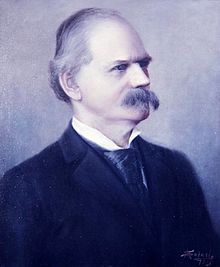|
John Marshall Stone
John Marshall Stone (April 30, 1830 – March 26, 1900) was an American politician from Mississippi. A Democrat, he served longer as governor of that state than anyone else, from 1876 to 1882 and again from 1890 to 1896. He approved a new constitution in 1890 passed by the Democratic-dominated state legislature that disfranchised most African Americans, excluding them from the political system[1] for more than 75 years. Early lifeBorn in Milan, Tennessee, Stone was the son of Asher and Judith Stone, natives of Virginia who were part of the migration to the west. He did not attend college since his family was fairly poor, but he studied a great deal and eventually taught school. He lived in Jacks Creek, Tennessee before moving to Tishomingo County, Mississippi in 1855.[2] Stone became a station agent at Iuka when the Memphis and Charleston Railroad opened. American Civil WarWith the outbreak of the American Civil War in 1861, Stone enlisted in the Confederate States Army that April. He commanded Company K of the 2nd Mississippi Infantry Regiment and saw action in Virginia. In 1862, Stone was elected colonel of his regiment. Stone was highly commended by his division commander Maj. Gen. Henry Heth, and in 1864, he frequently commanded the brigade. In January 1865, he recruited in Mississippi and commanded local troops countering Stoneman's 1865 Raid. He and his men were captured in North Carolina and imprisoned in Camp Chase, Ohio; later transferred to Johnson's Island, Ohio. Political career At the end of the war, Stone returned to Tishomingo County. He was elected mayor and treasurer. In 1869, he won a race to become state senator, winning re-election in 1873. State elections were marked by fraud and violence; the Red Shirts, a paramilitary group, worked to disrupt and suppress black voting and turned Republicans out of office. After Governor Adelbert Ames resigned in 1876, Stone, who was president pro tempore of the Mississippi State Senate at that time, served as the acting governor. In the 1877 election, Stone won the governor's office as a Democrat. In 1881 he was defeated for re-election by Robert Lowry. Stone became governor again after winning the 1889 election. The gubernatorial term was extended through 1896 by the new Mississippi Constitution of 1890. Later lifeFollowing his term as governor, in 1899, Stone accepted a position as the 2nd President of Mississippi A&M (now Mississippi State University) in Starkville. Stone died in Holly Springs, Mississippi, in 1900, at 69. He is buried at Oak Grove Cemetery in Iuka, Mississippi.[3][4][5] Personal lifeAfter the war, Stone married Mary G. Coman in 1872. The couple had two children who died young. They adopted three children of John's brother and raised them as their own. Legacy and honors
See also
References
External linksWikimedia Commons has media related to John Marshall Stone. |
||||||||||||||||||||||||||||||||||||||||||



